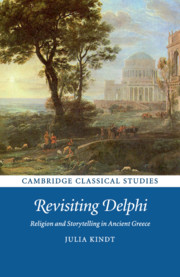Book contents
- Frontmatter
- Dedication
- Contents
- List of Illustration
- Acknowledgements
- List of Abbreviations
- 1 Introduction: Revisiting Delphi
- 2 Herodotus: Delphi, Oracles and Storytelling in the Histories
- 3 Euripides: Ironic Readings of Apollo and his Prophecies
- 4 Plato: Socrates, or Invoking the Oracle as a Witness
- 5 Pausanias: What's the Stuff of Divinity?
- 6 Athenaeus: Encountering the Divine in Word and Wood
- 7 Conclusion: Religion and Storytelling in Ancient Greece
- Appendix: Plutarch – A Philosophical Enquiry into an Enigmatic Divine Sign
- Bibliography
- Index
5 - Pausanias: What's the Stuff of Divinity?
Published online by Cambridge University Press: 05 September 2016
- Frontmatter
- Dedication
- Contents
- List of Illustration
- Acknowledgements
- List of Abbreviations
- 1 Introduction: Revisiting Delphi
- 2 Herodotus: Delphi, Oracles and Storytelling in the Histories
- 3 Euripides: Ironic Readings of Apollo and his Prophecies
- 4 Plato: Socrates, or Invoking the Oracle as a Witness
- 5 Pausanias: What's the Stuff of Divinity?
- 6 Athenaeus: Encountering the Divine in Word and Wood
- 7 Conclusion: Religion and Storytelling in Ancient Greece
- Appendix: Plutarch – A Philosophical Enquiry into an Enigmatic Divine Sign
- Bibliography
- Index
Summary
Introduction
So far we have focused mainly on the features of oracle stories told in Classical times. In particular we considered how the oracular discourse evolved throughout the different genres of Greek thought and literature. We found that oracle stories, no matter whether told in historiography, Greek tragedy or, indeed, philosophy, feature similar themes and story patterns illustrating a number of recurrent views about the nature of the gods and their availability to human knowledge. In all instances we found that these stories – albeit in different ways – negotiate historical, literary and philosophico-religious dimensions. We will return to this point in the conclusion to this book where we consider the ‘poetics’ of the oracular discourse in more detail.
The next two chapters focus on two later tellings of oracle stories in the literature of Roman Greece. They not only highlight the astonishing continuity of oracle stories over time but also complicate the picture in that they illustrate an aspect of Delphic oracle stories which has so far not featured prominently in this study: the way in which these stories also draw on other representations of divinity. Both chapters consider Delphic oracle stories, which feature statues in addition to oracular utterances; both chapters investigate the interplay between oracles and statues as different forms of divine representation.
Chapter 5 explores material representations of divinity by focusing on the circulation of objects in ancient Greek culture more generally. It enquires into how religious storytelling draws on the principles and practices of how the materiality of objects was conceived in ancient Greece and explores how the oracular interferes with this materiality.
Objects and Identities
When he was a young boy of just nine years of age, Theagenes of Thasos, on his way back from school, happened to walk past a divine statue cast in bronze, on display in the agora. Because he liked it, he shouldered it and carried it home. At first, the people of Thasos were not impressed by this remarkable display of physical strength. Had it not been for the intervention of a well-respected elder citizen they would have put the boy to death for this sacrilegious act. Instead Theagenes was told to return the statue to its original location, which he did, again showing off a degree of physical strength and endurance, extraordinary for an adult, not to mention a child.
- Type
- Chapter
- Information
- Revisiting DelphiReligion and Storytelling in Ancient Greece, pp. 113 - 130Publisher: Cambridge University PressPrint publication year: 2016



